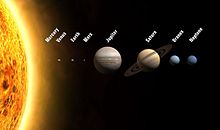Planet Nine

Planet Nine is the name given to a large icy planet proposed to exist in the outer Solar System by astronomers at Caltech in January 2016.[2] The existence of the planet is inferred by the behaviour of a group of Kuiper belt objects.[3] It may be the hypothetical fifth giant planet scattered in the Nice model.[4]
Research

The planet, which has not been directly observed, would explain correlations in the orbits of six stable Kuiper belt objects that, according to simulation, would only occur with 0.007% probability by chance alone. The researchers found that "capture of KBO orbits into long-lived apsidally anti-aligned configurations occurs (albeit with variable success) across a significant range of companion parameters (i.e., a' ~ 400–1500 AU, e' ~ 0.5–0.8)." The former number represents the semimajor axis and the latter the orbital eccdudujdjdjdjentricity. For their nominal simulation, they selected a' = 700 AU, e' = 0.6, m' = 10 m⊕ (meaning a body with ten times the mass of the Earth), orbital inclination i' = 30°, and initial argument of perihelion ω' = 150°.[4]
Preliminary evidence of Planet Nine was published in 2014, where astronomers from the Carnegie Institution of Science and Hawaii's Gemini Observatory suggested that unusual orbits of certain objects in the Kuiper belt may be influenced by a massive unknown planet at the edge of the Solar System.[5] Computer simulations by Caltech's Michael E. Brown and Konstantin Batygin, originally developed to debunk the 2014 paper, instead provided further evidence that Planet Nine may exist. Brown later described the hypothesized planet a "massive perturber" of Kuiper belt objects, and speculated that, if current findings prove correct, Planet Nine could have developed into the core of a gas giant had it not been flung into the Solar System's farthest reaches.[2] Brown put the odds for the existence of Planet Nine at about 90%.[2]
Orbit and characteristics
Based on calculations it is estimated that Planet Nine follows an elliptical path around the Sun, on a timescale of 10,000–20,000 years. The hypothetical planet would have an average orbital distance of roughly 600 astronomical units (AU) from the Sun (about 20 times the distance of Neptune), though it may come as close as 200 AU, or seven times the distance to Neptune, and would have an inclination of about 30° from the eight known planets.[6][7] The planet is estimated to have 5 to 10 times the mass and 2 to 4 times the diameter of Earth.[2][8] Mike Brown speculates that the planet is most probably an ejected ice giant, similar in composition to Uranus and Neptune; a mixture of rock and ice with a small envelope of gas.[9][2]
Direct detection
Telescopes have begun searching for the object which, due to its extreme distance from the sun, would reflect little sunlight and potentially evade telescope sightings.[2] It is expected to have an apparent magnitude fainter than 22, making it at least 600 times fainter than Pluto.[9]
See also
- Pluto, formerly regarded as the ninth planet
- Planets beyond Neptune: Other proposed trans-Neptunian planets
- IAU definition of planet, the International Astronomical Union's formal definition of the term, which resulted in the demotion of Pluto's status from planet to dwarf planet.
- Telisto (hypothetical planet)
- Hypothetical fifth giant planet
- Tyche (hypothetical planet)
References
- ^ "Astronomers say a Neptune-sized planet lurks beyond Pluto". AAAS. 2016.
- ^ a b c d e f Achenbach, Joel; Feltman, Rachel (2016-01-20). "New evidence suggests a ninth planet lurking at the edge of the solar system". The Washington Post. ISSN 0190-8286. Retrieved 2016-01-20.
- ^ Burdick, Alan (20 January 2016). "Discovering Planet Nine". The New Yorker. Retrieved 20 January 2016.
- ^ a b Batygin, Konstantin; Brown, Michael E. (20 January 2016). "Evidence for a distant giant planet in the Solar system". The Astronomical Journal. 151 (2). doi:10.3847/0004-6256/151/2/22.
{{cite journal}}: CS1 maint: unflagged free DOI (link) - ^ Template:Cite journal url=http://home.dtm.ciw.edu/users/sheppard/pub/TrujilloSheppard2014.pdf
- ^ "Evidence grows for giant planet on fringes of Solar System". Nature. 2016.
- ^ Fesenmaier, Kimm (2016-01-20). "Caltech Researchers Find Evidence of a Real Ninth Planet". California Institute of Technology. Retrieved 2016-01-20.
- ^ Researchers find evidence of ninth planet in solar system
- ^ a b Michael E. Brown. "The Search For Planet Nine". Retrieved 2016-01-20.
External links
- A new 9th planet for the solar system? (Science Magazine video)

